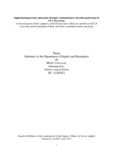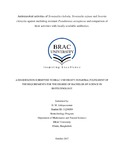Evaluation of analgesic, antipyretic, hypoglycemic and CNS depressant activity of 2-bromopopylamine hydrobromide, 3-bromopopyl ammonium bromide, ortho-amino aniline and benzimidazole-2-thiol in animal model
Citation
Hamiduzzaman, M., Mannan, S. J., Dey, A., & Abdur Rahman, S. M. (2014). Evaluation of analgesic, antipyretic, hypoglycemic and CNS depressant activity of 2-bromopopylamine hydrobromide, 3-bromopopyl ammonium bromide, ortho-amino aniline and benzimidazole-2-thiol in animal model. Der Pharmacia Lettre, 6(1), 47-53.Abstract
Synthetic compounds are encompassing the major ther
apeutic classes of drugs which resemblance to the n
atural or
existing therapeutically active compounds. Herewith
four synthetic compounds i.e. 2-bromopropylamine
hydrobromide, 3-bromopropyl ammonium bromide, ortho
-amino aniline and benzimidazole-2-thiol were subje
cted
for analgesic, antipyretic, hypoglycemic and CNS de
pressant activity in mice and rat model following s
tandard
protocol. Among the four supplied synthetic compoun
ds, benzimidazole-2-thiol and 3-bromopropyl ammoniu
m
bromide at a dose of 50 mg/kg body wt revealed sign
ificant analgesic activity with 37.85% and 42.85% i
nhibition of
writhing (P value < 0.001 in both cases). None of t
he test samples showed antipyretic activity in rat
model at a dose
of 50 mg/kg body wt in comparable with standard ant
ipyretic drug Paracetamol. On the other hand benzim
idazole-
2-thiol reduced blood glucose level with respect to
standard drug Glibenclamide having P value 0.00082
and 3-
bromopropyl ammonium bromide lengthened the Na-phen
obarbitone induced sleeping time having the P value
0.0009 which was statistically significant.
Keywords
Analgesic activity; Antipyretic activity; CNS depressant activity; Hypoglycemic activity; Synthetic compoundsDepartment
Department of Pharmacy, BRAC UniversityType
ArticleCollections
- Journal Article [1]
Related items
Showing items related by title, author, creator and subject.
-
Implementing learner autonomy through communicative activities performed in CLT classroom : an investigation of the learner's preferred activities which are carried out in CLT classroom and the potential of these activities to promote learner autonomy
Islam, Sabrina Anjum (BRAC University, 2013-04)Learner autonomy is in the heart of CLT approach. It is one of the central issues of Communicative Language Teaching. According to Holec’s (1981) definition learner autonomy means “ability to take charge of one’s own ... -
Comparative study of antidiabetic activity of Cajanus cajan and Tamarindus indica in alloxan-induced diabetic mice with a reference to in vitro antioxidant activity
Nahar, Laizuman; Haque, Ekramul; Nasrin, Fatema; Mosaddik, Ashik; Zahan, Ronok; Haque, AnamulOxidative stress not only develops complications in diabetic (type 1 and type 2) but also contributes to beta cell destruction in type 2 diabetes in insulin resistance hyperglycemia. Glucose control plays an important role ... -
Antimicrobial activities of Terminalia chebula, Terminalia arjuna and Swertia chirayita against multidrug resistant Pseudmonas aeruginosa and comparison of their activities with locally available antibiotics.
Ashiquzzaman, D. M. (BRAC University, 2017-10)The continuous emergence of resistant bacteria is endangering the efficacy of antibiotics across the globe. The antibiotic resistance crisis has been occurring due to the overuse and misuse of these medications. However, ...


